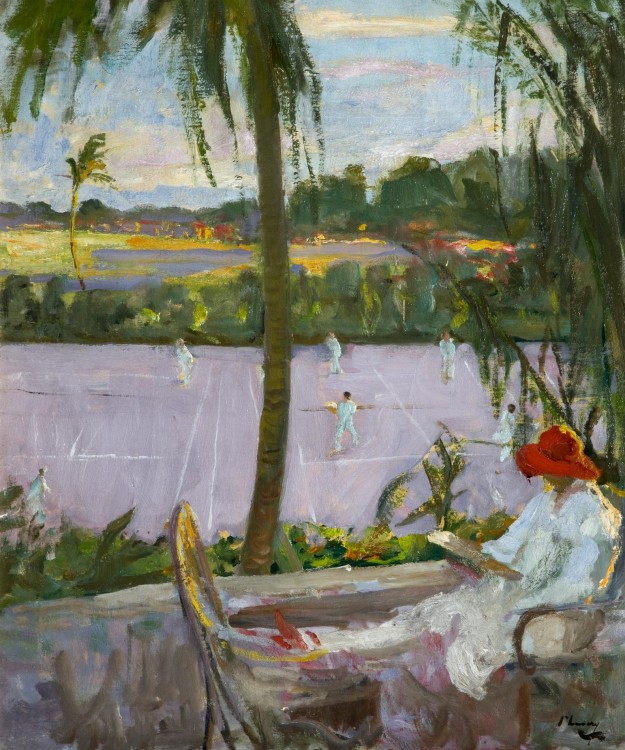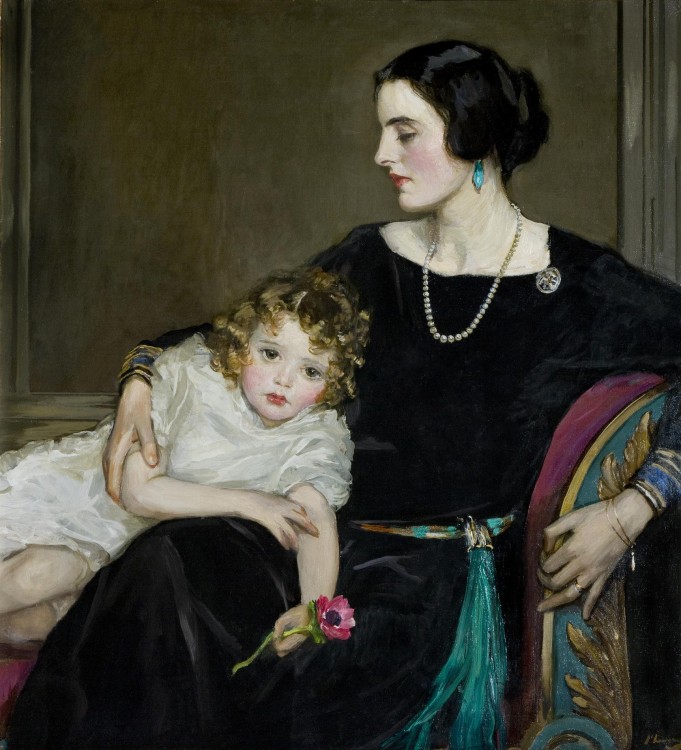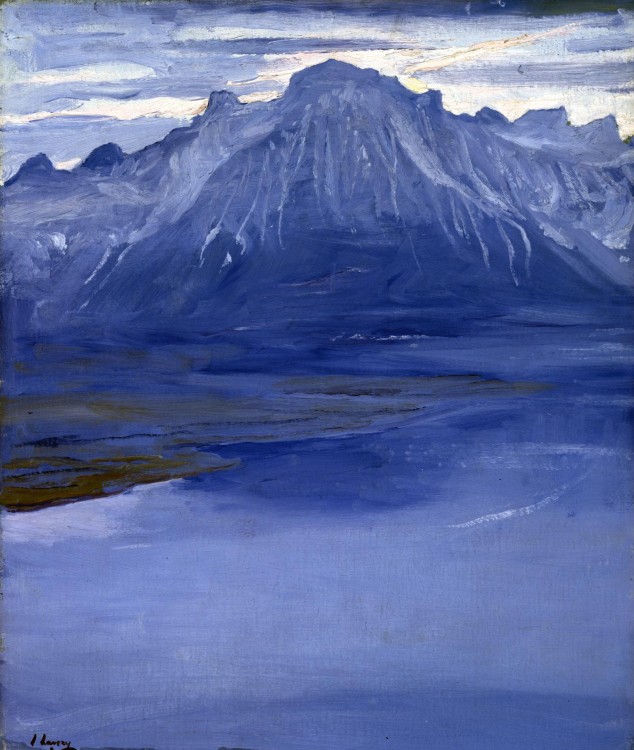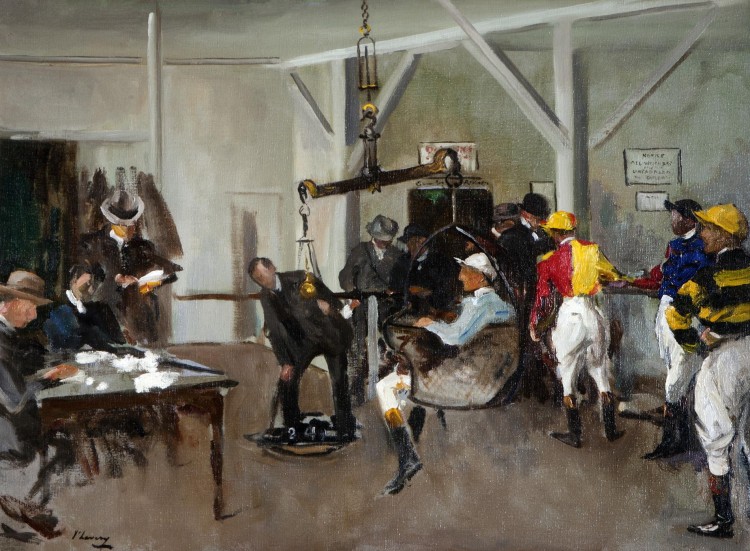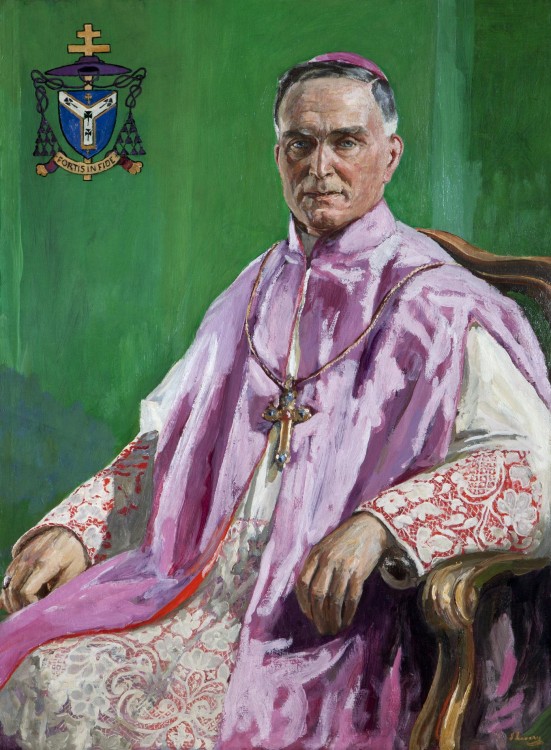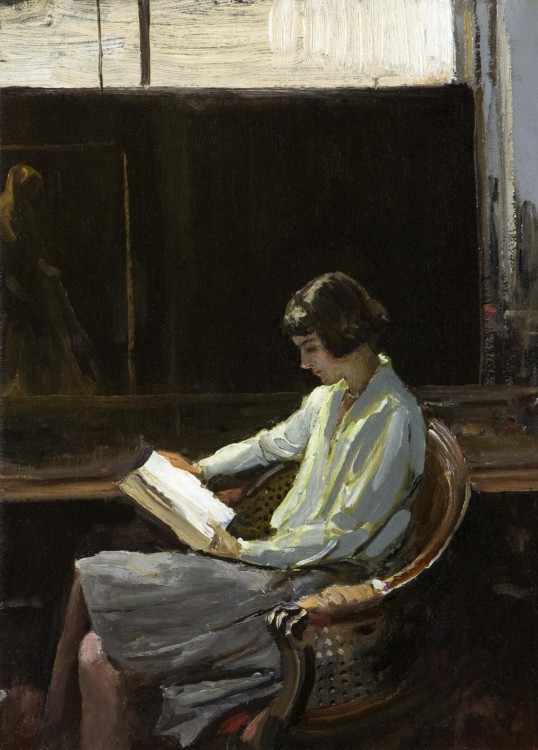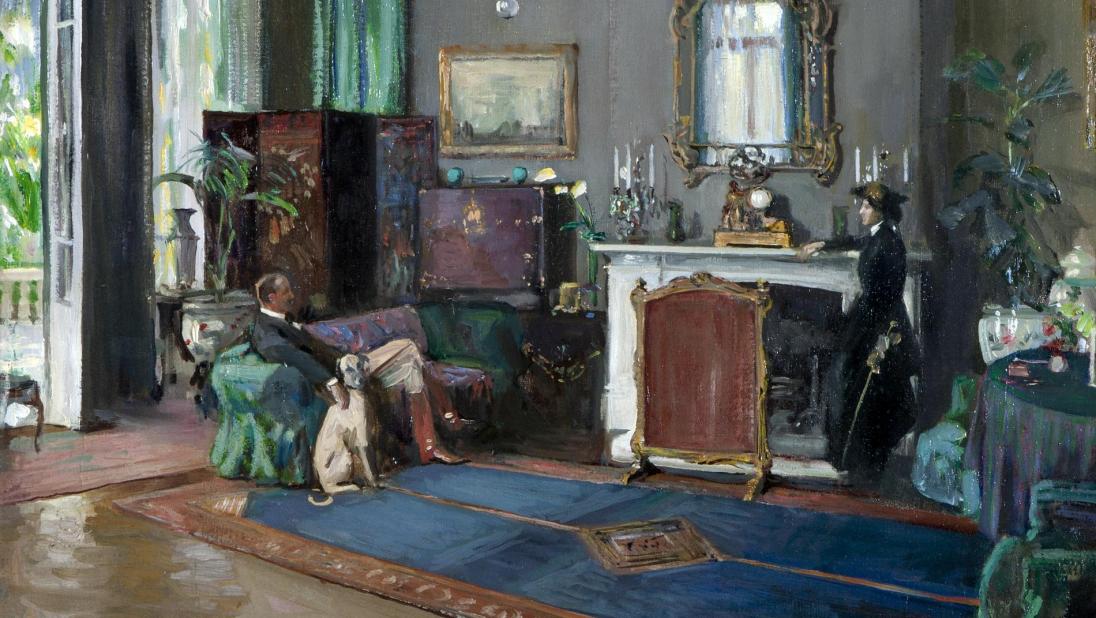
the works of sir john lavery
Explore the collection onlineBorn in Belfast, Lavery was orphaned early in his life. He was sent to Scotland in 1866 and began his career in Glasgow, working in a photography studio and making art in his spare time. He progressed quickly as a painter and during the 1880s he visited Paris and the artists’ colony at Grez-sur-Loing, near Fontainebleau, where he painted several significant works.
In 1888 he was commissioned to paint The State Visit of Queen Victoria to the Glasgow International Exhibition, and the resulting studies launched his career as a society portraitist. By 1910 he had become an artist of international renown and by the 1930s had collected many accolades and titles.
In 1929 he gave the Belfast Museum and Art Gallery (now the Ulster Museum) thirty-four paintings, for two reasons he said: ‘one that I was born in Belfast, and the other that they had built a gallery there, but had no pictures to put in it’.

Sir John and Lady Lavery standing in front of the display of Lavery paintings in the Ulster Museum. Dated May 1929.
He was a very diverse artist and painted a huge range of subject matter, from regal and society portraits to spontaneous images of the people he knew best, as well as landscapes and seascapes. Lavery perfected the oil sketch as a means of planning his compositions and during his frequent travels to North Africa, Switzerland and France he evolved subtle colour harmonies which show the influence of Whistler.
We would like to thank Dr Kenneth McConkey for his research on Sir John Lavery.
Early artistic education in France

Under the Cherry Tree 1885
Under the Cherry Tree was painted at Grez-sur-Loing, a small village on the river Loing, south of Fontainbleu, near Paris, where artists had gathered since the 1860s. Lavery worked there in 1883 and 1884 and it was during that time that he developed his new ‘plein-air’ style; working outside directly from nature. When first exhibited at the Glasgow Institute in 1885 this painting bore the title On the Loing: An Afternoon Chat. Under the Cherry Tree is larger and more ambitious than any work Lavery had previously attempted. It is a youthful masterwork, heavily influenced by Bastien-Lepage and was intended to display the painterly techniques he had recently acquired through study in France. The composition of Under the Cherry Tree is divided into three distinct areas and Lavery employed a different technique in the painting of each, including the finely observed vegetation in the foreground and the misty rendition of bridge and foliage in the background.

The Bridge at Grès, 1901
Late in the 1890s, Lavery returned to rural France and revisited Grez-sur-Loing, In The Bridge at Gres he used almost the same view as Under the Cherry Tree. The Bridge at Grès was painted quickly, almost in a single session, and is one of the finest examples of Lavery’s increasingly sophisticated landscape paintings. The horizon line is set high in the painting and the figures only sketchily observed. The real subject of the painting is the river surface, which recalls Monet’s fascination with the effects of light on water.
The influence of Whistler

Eileen, her first communion, 1901
Lavery often painted those he was closest to, and these two works show his much-loved daughter Eileen at two very different stages - in childhood, and with a child of her own. Eileen was Lavery’s only child, the daughter of his first wife, Kathleen, who died shortly after her daughter’s birth. In this sketch for a larger painting, Lavery concentrates on the subtle graduations of tone between white and grey of her gown and veil.
Lavery was strongly influenced by fellow painter James Abbott McNeill Whistler, in particular his delicate and restrained colour harmonies. He kept in regular contact with Whistler from the time they met in 1887 and gave him considerable assistance when he formed the International Society of Sculptors, Painters and Gravers in 1897-8, acting as vice-president alongside Whistler as President. Whistler was, in fact, staying with Lavery when he painted Eileen, aged seven, on holiday from her convent boarding school.

The Mother, 1909
The influence of Whistler is also very apparent in the soft brushstrokes and tonal qualities of grey and pink paint in this tender work, The Mother. This portrait began life in 1909, as a profile study of Lavery’s friend and model Mary Auras, and ended as a study of motherhood in 1924, showing his daughter Eileen with her child.
Lavery and Whistler remained close until Whistler’s death in 1903.
Exotic surroundings

Tangier Bay Sunshine (1920)
Lavery visited Morocco for the first time in 1890 and spent a lot of time in Tangier during the 1900s and 1910s. He was attracted by the strong light and brilliant colours of the north African landscape.
During these years he painted many beach scenes and seascapes often using bands of delicately coloured paint to represent the seas of the southern Mediterranean.
In the far distance of this seascape, a small warship patrolling the straits of Gibraltar appears as a finely traced smoke-trail. This could be a reference to the growing international unease in the years leading up to the outbreak of war in 1914.
Lavery revisited the same bay ten years later to paint it in sunshine.
Lavery had exhibited at the Venice Biennale exhibition in 1910 with the city probably inspiring him to experiment more with seascape painting.
Royal connections

Second Study for the King, the Queen, the Prince of Wales, the Princess Mary, Buckingham Palace (1913).
In 1912 Lavery was commissioned to paint the Royal Family for the fee of £2,000. Consistent with previous practice, the painter combined individual head studies with the setting and produced two oil sketches of the group for the Queen’s approval, one of which was given to the Ulster Museum.
The finished work, now in the National Portrait Gallery, was exhibited at the Royal Academy in 1913 and was much admired. King George V and Queen Mary visited Lavery’s London studio while the full-sized picture was being painted. It so impressed them that the King asked if he could have a hand in it. Lavery mixed some royal blue on a brush, and the King applied it to the blue ribbon of the Order of the Garter. Queen Mary, not wishing to be outdone, followed his example.
The painting was regarded as a ‘considerable success’ by The Times, and praised for its ‘subtle blending of colour in the atmosphere’. It was inspired by Diego Velazquez’s Las Meninas, and painted at the same time as another significant Lavery work, The Artist’s Studio, now in the National Gallery of Ireland.
War years

Daylight raid from my studio window 1917
Lavery was a famous artist at the time of the First World War. Under doctor’s orders he was unable to join the Army but in 1914 chose to depict the treatment of the first wounded soldiers at the London Hospital. His plans to go to the Western Front to paint the true war experience were discouraged by his wife Hazel, and he continued to paint in London.
Daylight Raid from my Studio Window records the afternoon of 7 July 1917, when twenty-one German biplanes appeared in the skies above London and were engaged by British aircraft. The ensuing combat could be seen from the large window of Lavery’s studio in Cromwell Place, London. The artist’s wife Hazel, her head outlined against a blackout curtain, is watching the scene, worry evident in the tension of her body. Lavery seems to have originally painted a statuette of the Virgin Mary, in front of which Hazel kneeled. Before he donated the painting to Belfast, he painted it out, possibly to erase the memory of his wife’s worry.
Lavery was adept at recording moments like this, in rapid, impressionistic oil sketches. Here he uses quick, fluid brushstrokes to describe both the clutter of his studio and the menacing presence of the tiny planes in the clear sky beyond.
Powerful portraits

His Eminence Cardinal Logue 1920
Lavery became very famous during his lifetime for his powerful and commanding portraits of well-known personalities including politicians and religious figures. Although born in Belfast, Lavery had very little contact with his native city until his friendship with Sir Hugh Lane, an art collector and the founder of Dublin Municipal Museum of Modern Art, drew him back into Irish artistic life and politics. After this, Lavery painted a series of portraits of prominent figures, of which these are two of the most impressive.
These formidable three quarter length paintings demonstrate Lavery’s direct and sombre style of portraiture when it came to male figures. Michael Logue, was born in Carrigart, County Donegal in 1840 and became Archbishop of Armagh in 1888. A keen Irish speaker and supporter of the Gaelic League, Cardinal Logue was eighty-years old when he sat for this portrait. It shows Lavery using the more forceful style, vivid colours and looser technique that characterise his later portraits.

Viscount Craigavon 1923
This second portrait is of James Craig, who was born in Belfast into a distilling family. He rallied the opposition to Irish Home Rule in Ulster before 1914 and organised the paramilitary Ulster Volunteers which became the nucleus of the 36th (Ulster) Division during the First World War. In 1921, Craig succeeded Edward Carson as leader of the Ulster Unionist Party, and later that year became the first Prime Minister of Northern Ireland. This portrait was painted in 1923, and he was created the 1st Viscount Craigavon in 1927.
Lady Hazel Lavery

The Green Coat
Lavery married his second wife, Hazel Martyn, in 1909. She was a beautiful and artistic young American, with striking good looks and theatrical poise. This splendid and dramatic painting was one of several portraits he painted of her. In 1917 Lavery painted her as The Madonna of the Lakes for St Patrick’s, the church in Belfast where he was christened, and in 1927 as Kathleen ni Houlihan, the personification of Ireland, for the currency of the new Irish State.
There is an interesting juxtaposition here between the elaborate nature of the green coat and delicate, feminine dress, and the bare shoulders and exposed neck of the subject. Hazel looks beautiful but somewhat lost among her opulent surroundings, and capturing his wife lost in thought and looking slightly vulnerable, despite her finery, suggests the depth of the relationship between the artist and the sitter.
In its original form, where Hazel’s arms and shoulders were bare without the coat, the painting was used as an advertisement for Pond’s Cream, which Lady Lavery herself endorsed. She was very happy for the finished painting to be given to the Belfast Art Gallery, saying ‘it is to my thinking the best one of me he has ever painted’.
Later work

The Red Hammock
This large-scale work was one of the latest painted by Lavery, when he was eighty-years old.
Around 1907 he had painted many sketches at Ranelagh, Dublin for ‘hammock’ pictures, depicting a young woman reading under the trees on a summer’s day. Now a new model, Lillian Millar, began posing for a series based on this theme.
Lavery had donated a painting of The Red Hammock to the Belfast Museum and Art Gallery in 1930 but requested its return in 1936 to restore it after becoming aware of its deterioration. However, upon seeing it he decided to produce a new version rather than attempt a repair of the original. It was a dreamy celebration of youth and sensuality, the effects of the sun dappling the garden in the afternoon showing off the various textures and colours of the female figure’s clothes, parasol and hammock.
The Edwardian rococo escapism of the painting was slightly at odds with a more modern time, and painted only a short time before the outbreak of the Spanish Civil War and Hitler’s occupation of the Rhineland. While not considered one of his finest works, it shows the artist still striving to produce an attractive and sensitive large-scale painting, even in his advanced age.
Self reflection

Self Portrait, 1928
Lavery was seventy-two when he painted this self-portrait. He wears a white painting coat and includes one of his most recent subjects, swimmers at the newly-opened Chiswick Baths in London, to give the work a sense of youthfulness and modernity. The self-portrait is also slightly self-mocking, as the artist appears in an oval frame associated with more traditional forms of portraiture, and appears to have been caught in the process of painting his own portrait.
Lavery was a very well-known and respected artist at the time he painted this portrait. When he received the Freedom of Belfast, in 1930, he became the first artist to be so honoured. In that year he was one of the first twelve academicians of the Ulster Academy of Arts; he was later appointed President and retained that office until his death. This image shows the artist in control of his craft, willing to experiment a little with the setting but retaining a bold confidence in himself and his abilities.
Sir John Lavery died in County Kilkenny, aged 84.
